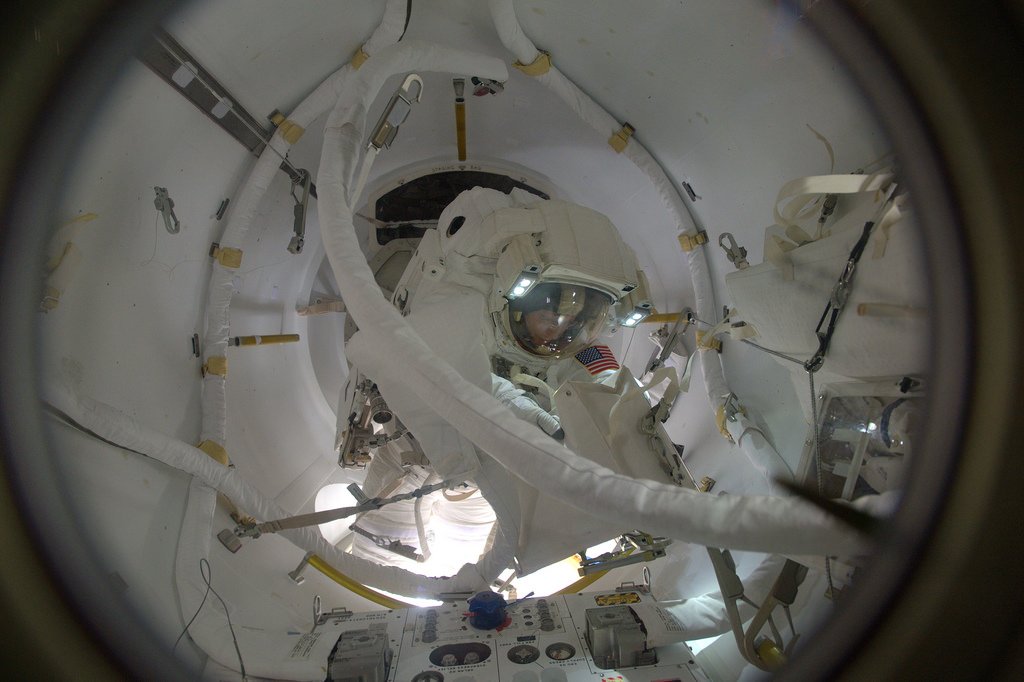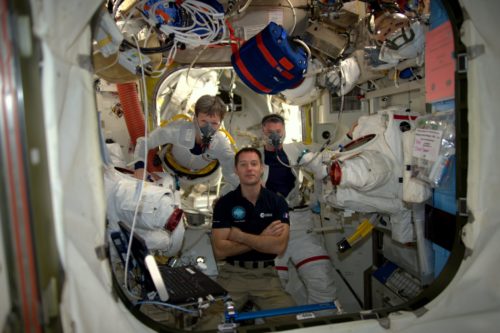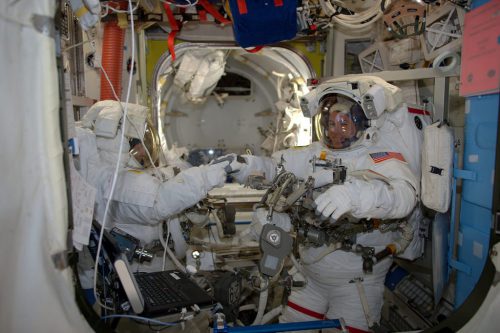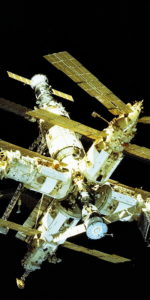
Two U.S. astronauts, including the oldest woman ever to participate in an Extravehicular Activity (EVA), triumphantly concluded a six-hour and 32-minute spacewalk outside the International Space Station (ISS) earlier today. Expedition 50 Commander Shane Kimbrough and Flight Engineer Peggy Whitson breezed through the task of installing three new adapter plates and hooked up electrical connectors for a trio of new lithium-ion (Li-Ion) batteries on the starboard-side S-4 segment of the station’s Integrated Truss Structure (ITS). Their work heralds the start of a two-year campaign of EVAs and robotics, which will see 48 aging nickel-hydrogen batteries on the port and starboard trusses replaced with 24 smaller, but higher-performing, lithium-ion ones. Working around an hour ahead of the timeline, Kimbrough and Whitson were also able to complete several “get-ahead” tasks, including a photographic survey of the station’s Alpha Magnetic Spectrometer (AMS-2).
Today’s spacewalk was designated “U.S. EVA-38” and represented the 38th spacewalk to be conducted out of the Quest airlock, with astronauts clad in U.S.-built Extravehicular Mobility Units (EMUs) and conducted in the absence of the space shuttle. Since U.S. EVA-1, way back in February 2002, these excursions have outfitted new hardware, removed and replaced faulty equipment, reconfigured coolant loops, tackled ammonia leaks, and laid cables in readiness for Commercial Crew operations and the arrival or relocation of pressurized modules. Last summer, Expedition 48 spacewalkers Jeff Williams and Kate Rubins performed EVAs 36 and 37 to install an International Docking Adapter (IDA-2) onto the Harmony node and retract the Trailing Thermal Control Radiator (TTCR) on the station’s port-side P-6 truss.
These U.S. Orbital Segment (USOS)-based EVAs have been performed not only by NASA astronauts, but have also involved German, Russian, Japanese, Italian, and British nationals. They have seen a number of records secured, including Sunita Williams becoming the most experienced female spacewalker and holder of the greatest number of EVAs—seven—ever conducted by a woman. Yet during today’s EVA-38, one of Williams’ achievements was equaled, as Peggy Whitson ventured outside for her seventh career spacewalk and established a new record. Aged 56, she eclipses Linda Godwin as the oldest woman to perform an EVA. Godwin was 49 years old when she spacewalked outside the ISS during the STS-108 shuttle mission in December 2001.

In readiness for EVA-38, the Expedition 50 crew—which also includes Frenchman Thomas Pesquet and Russian cosmonauts Sergei Ryzhikov, Andrei Borisenko, and Oleg Novitsky—spent part of the Christmas period checking out and performing maintenance on EMUs #3006 and #3008, inside the Quest airlock. A water leak in the Service and Cooling Umbilical (SCU) on #3008 forced an initial loop scrub task to be delayed, but it was completed successfully last week. Additionally, the astronauts filled the Liquid Cooling Ventilation Garments (LCVGs) with water and performed a fit-check of the suits on 27 December. This week, they configured tools, reviewed cuff checklist procedures, and participated in a conference with ground-based specialists.
The focus of EVA-38 and the next planned USOS-based spacewalk, EVA-39, which will occur on Friday, 13 January, is to remove 12 aging nickel-hydrogen batteries from the S-4 truss segment and replace them with six smaller lithium-ion batteries. The latter were delivered to the ISS last month aboard Japan’s latest H-II Transfer Vehicle (HTV-6). The EVAs were originally planned for October 2016, but delays to the HTV-6 launch pushed them several months to the right. At length, HTV-6 arrived at the station and was robotically berthed at the Earth-facing (or “nadir”) port of the Harmony node on 13 December.
Although loaded with a wide range of supplies, the critical components for EVAs 38 and 39 were the six new batteries, located aboard HTV-6’s External Pallet. Each lithium-ion unit has a capacity approximately equivalent to two nickel-hydrogen batteries, allowing for the six brought uphill by HTV-6 to replace all 12 aboard the S-4 truss. All told, by 2020, it is expected that all 48 of the station’s nickel-hydrogen batteries—situated on the massive Integrated Equipment Assemblies (IEAs) on the port-side P-4 and P-6 trusses and on the starboard-side S-4 and S-6 trusses—will have removed and replaced by a total of 24 lithium-ion batteries.
The old batteries each weigh around 375 pounds (170 kg) and were tasked with storing electrical power from the solar arrays and routing it through the Battery Charge/Discharge Units (BCDUs) and Direct Current Switching Units (DCSUs) to on-board ISS systems. Originally intended to support a design life of 6.5 years, and the capacity to exceed 38,000 charge/discharge cycles at 35-percent depth of discharge, the station’s lower than anticipated power demands meant that they actually lasted almost a full decade, and 50,000 charge/discharge cycles, before replacement. In July 2009 and May 2010, spacewalkers on the STS-127 and STS-132 shuttle missions changed out the original batteries on the P-6 truss, which had been on-orbit for almost a decade at that stage.
In the meantime, efforts to design and develop the new lithium-ion batteries got underway with preliminary risk and feasibility studies in 2009-2010, ahead of ISS Program Authority to Proceed in December 2011. This called for the fabrication of 27 lithium-ion batteries, plus 25 on-orbit adapter plates to cover the empty nickel-hydrogen battery “slots” and maintain the integrity of the thermal control loops. GS Yuasa Lithium Power, Inc., was selected in November 2012 to build the battery cells. Its proposal was based upon its LSE134 cell, which has been described as “ideally suited” to the electrical, size, and mass requirements for the ISS. “The LSE134 approximately triples the available energy storage on both a per-mass and a per-volume basis relative to the existing nickel-hydrogen battery,” it was noted, “and is capable of powering critical ISS systems well beyond the required ten-year service life.”
Each new battery weighs 430 pounds (195 kg), with each associated adapter plate weighing-in at approximately 65 pounds (29 kg). The new batteries should function for at least a decade—far beyond the space station’s remaining lifetime, which is expected to end in December 2024—and handle 60,000 charge/discharge cycles. Moreover, their integration requires no change to the existing IEA interfaces or hardware.

Following HTV-6’s arrival and berthing at the space station last month, efforts quickly entered high gear to get the Orbital Replacement Unit (ORU) pallet, bearing the new batteries, ready for action. On 14 December, the Robotics Officer (ROBO) in the Mission Control Center (MCC) at the Johnson Space Center (JSC) in Houston, Texas, extracted the ORU pallet from the Japanese cargo ship, by means of the 57.7-foot-long (17.6-meter) Canadarm2. Over the Christmas and New Year period, ground controllers then employed the arm’s Dextre robotic “hand” to install three of the six lithium-ion batteries into the Power Channel 3A IEA on the S-4 truss. Dextre also removed four old nickel-hydrogen batteries from the IEA and stowed three of them onto HTV-6’s External Pallet for disposal. The fourth old battery was temporarily stowed on a platform on Dextre.
This set the stage for today’s EVA-38, during which Kimbrough and Whitson were to install three adapter plates into slots on the 3A IEA. These will house three of the old nickel-hydrogen batteries, which will remain aboard the ISS, albeit in a dormant state. The other nine old batteries will be loaded aboard HTV-6 and destroyed at the end of its mission, later this month. Nine batteries is the maximum number that can be carried aboard the Japanese cargo ship, hence the reason why three batteries will remain behind.
Kimbrough, designated “EV1” and sporting red stripes on the legs of his EMU for identification, and Whitson as “EV2,” in a pure white suit, bring a huge amount of experience to the table. The former had two previous spacewalks under his belt, totaling almost 13 hours, whilst the latter performed six EVAs and attained almost 40 hours of time working outside the ISS. Assisted by Pesquet and Novitsky, the duo undertook 60 minutes of pre-breathing on masks early Friday. During this period, Quest’s inner “equipment lock” was depressed from its ambient 14.7 psi to 10.2 psi. They purged their EMUs shortly after 4 a.m. EST and the airlock’s atmosphere was repressurized back up to 14.7 psi. This enabled Kimbrough and Whitson to press into a nominal pre-breathing regime, lasting about 50 minutes, followed by another 50 minutes of In-Suit Light Exercise (ISLE). First trialed during the STS-134 shuttle mission in May 2011, the ISLE protocol serves to rapidly remove nitrogen from the spacewalkers’ bloodstreams, thereby avoiding a potentially fatal attack of the “bends” and skirting the need for Kimbrough and Whitson to camp-out in the airlock overnight.
With all tasks completed, the spacewalkers and their equipment were maneuvered into the outer “crew lock” by Pesquet and Novitsky shortly after 6:30 a.m. Hatches between the two locks were closed and the process of depressurization commenced, leading to the opening of the outer hatch. Transferring their suits’ life-support utilities onto internal battery power, EVA-38 officially began at 7:23 a.m., a few minutes later than timelined.
Neither Kimbrough or Whitson had performed a spacewalk since 2008, but both set about their initial tasks with gusto. After customary “buddy checks” of each other’s suits and tethers, Kimbrough headed up the airlock “spur” to the Crew and Equipment Translation Aid (CETA) cart, where he attached his crew lock bag onto an Articulating Portable Foot Restraint (APFR) and donned his Body Restraint Tether (BRT). Moving rapidly, he worked his way along the station’s starboard-side S-1 truss, pausing to change to a second tether, before advancing further outboard to the S-4 worksite. Meanwhile, Whitson followed him along the same translation path, heading for the External Pallet.
She employed a ratchet-like wrench to break torque on bolts on the three adapter plates, as Kimbrough installed a set of ORU Handling Devices (nicknamed “scoops”) and headed to the External Pallet to assist Whitson. They released the first adapter plate and attached it to Whitson’s BRT, and did likewise with a second adapter plate to Kimbrough’s BRT, then headed back to the IEA. Kimbrough ingressed the APFR and Whitson passed him the first adapter plate, which he bolted into position and attached a data-link cable between the plate and the new lithium-ion batteries. The data-link cables enabled mission controllers to perform a thorough checkout of the batteries.
By 9:30 a.m., approximately two hours into EVA-38, the Electrical Systems Officer reported good electrical and data-flow to the new battery. The second and third adapter plates quickly followed and were in place, with data-link cables hooked up at shortly after 11 a.m. By now, Kimbrough and Whitson were working well over 60 minutes ahead of the timeline. Four hours into the spacewalk, they were assigned several get-ahead tasks, previously assigned to next week’s EVA-39: namely a photographic survey of the AMS-2, completed by Kimbrough, and work to remove a failed external light, done by Whitson.
EVA-38 ended at 1:55 p.m. EST, after six hours and 32 minutes. It has now established Whitson as the joint holder of the greatest number of spacewalks accomplished by a woman, and she has now accrued 46 hours and 18 minutes across her career, placing her as the 14th most seasoned spacewalker of all time. She is closing fast on Sunita Williams’ all-time record of 50 hours and 40 minutes for the greatest number of EVA hours by a woman. Whitson previously seized the record for the world’s most experienced female spacewalker, from Williams, in December 2007, during Expedition 16, before losing it back to Williams in September 2012. If another EVA comes Whitson’s way during her current ISS increment, she can expect to regain the record once more.
Be sure to “Like” AmericaSpace on Facebook and follow us on Twitter: @AmericaSpace





